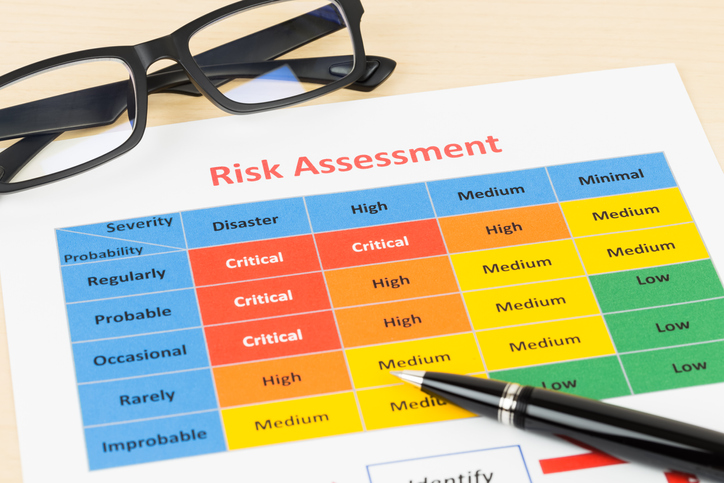Risks are inherent in every business. Your goal as a business owner isn’t to eliminate every risk your company faces. Let’s be real. Business owners are risk-takers, almost by definition, so complete risk avoidance just isn’t in the cards. Instead, understand the greatest risks to your business, assess the potential consequences, identify options for dealing with them, and implement the risk management tools that make the most sense.
As a business owner, you probably have the most critical business risks on your radar, but maybe you haven’t taken the time to write them down, think through how they could impact your business, and implement a plan for mitigating their potential consequences. If you haven’t done this exercise, there’s no better time than the present to make this investment in your business.
Risk Identification
Start by engaging your business team and outside experts like your insurance broker, business lawyer and accountant in a discussion of the internal and external risks that face your business. Remember, not all risks arise out of negative situations. Some may come from opportunities that are positive, like acquisitions or organic growth.
Internal risks fall in a variety of categories. Your business may be able to influence or control some of them. Examples include:
- Personnel — illness or death of key personnel, complacency and negative culture, resulting in administrative or operational gaps, turnover or a tarnished reputation
- Plant and Equipment — obsolete equipment, worn parts and faulty equipment due to lack of maintenance, causing shutdowns, significant unexpected cash outlays or fire hazards
- Information Technology — outdated, unreliable or unsecure systems or poor processes, risking downtime or security breaches
- Supply Chain and Logistics — limited vendors and suppliers and exclusive dealing arrangements limiting critical resources
- Legal Exposure — contracts with inadequate protections or unclear terms, unsafe facilities and ineffective compliance programs
- Finance — customer credit risk, poor budgeting and lack of cash flow
Categories of external risks that are largely outside the control of a business might include:
- Competition and Market Changes — increase in costs of transportation and wholesale goods, toughening competition and product obsolescence
- Business Environment — weather; natural disasters or pandemics causing property damage, business disruption or closure; and changes in laws impacting operations and costs of compliance
- Outside Commitments — family emergencies and other commitments requiring the attention of personnel
Also consider risks that public companies in your industry might disclose in the Form 10-Ks they file with the SEC. For example, if your business is a coffee shop, take a look at the most recent Form 10-K filed by Starbucks. These reports are chock full of valuable information that will be useful in your company’s risk assessment exercise.
Risk Assessment and Mitigation
Once the team identifies the risks, it should evaluate the potential consequences and how they might impact the company’s financials, operations, strategy and business reputation.
Then create a risk matrix. On one axis of the matrix, rank the likelihood of the risk occurring. On the other axis, rank the severity of the potential consequences. The objective is to address all unacceptable risks, but initially the team should focus on mitigating the risks with a higher probability of occurrence and a greater negative impact.
To illustrate, a flood at one of the company’s facilities may seem unlikely, but it could force the closure of the company’s largest production facility. Your company will incur costs for cleanup, production may be interrupted, employees may be displaced, and customers may shift their business — temporarily or permanently — to a competitor. This event has potentially far-reaching implications you’ll wish you had planned for.
Risk mitigation efforts to consider implementing in advance might include purchasing property casualty and business interruption insurance; developing a plan for communicating with employees, customers and vendors; having a contingency plan in place for continuity in production and order fulfilment; and ensuring company contracts include terms limiting liability to customers, vendors and others that might be impacted.
Remove the Blindfold
Owning a business can be an exciting journey. You will serve your company well by understanding the internal and external risks you’ll face and their potential impact on the company. Don’t make operational and strategic decisions wearing a blindfold. Instead, make them with your eyes wide open. While the journey may still be somewhat treacherous, at least you’ll have an idea where the dangers are lurking and have a plan in place for navigating them so you can reach your destination with the least amount of trouble as possible.

Sheryl Nelson is president of On Point Business Administration. Sheryl’s experience as a business and M&A lawyer provides a unique perspective to clients retaining On Point as outsourced chief administrative officer. That insight also benefits exiting business owners who need to get their businesses in order before going to market and responding to thorough due diligence requests from potential buyers.


